# 实验目的
- 熟悉类UNIX系统的I/O设备管理
- 熟悉MINIX块设备驱动
- 熟悉MINIX RAM盘
# 实验环境
开发环境:VS Code (GNU)
宿主机系统环境:Windows10 + WSL2(Ubuntu 20.04)
虚拟机应用:VMware WorkStation16
虚拟机环境:MINIX3
# 实验过程
# 源码版本回退
输入命令 git reset HEAD^即可回退到project-2的前一个版本(原始版本)
# 创建RAM盘并挂载
列出需要新增/修改的文件:
/usr/src/minix/drivers/storage/memory/memory.cM/usr/src/minix/commands/ramdisk/MakefileM/usr/src/minix/commands/ramdisk/buildmyram.cU
在
/usr/src/minix/drivers/storage/memory/memory.c中将RAMDISKS=6改为
RAMDISKS=7在
/usr/src/minix/commands/ramdisk/Makefile中添加PROG= buildmyram添加文件
buildmyram.c(仿照ramdisk.c实现)#include <minix/paths.h> #include <sys/ioc_memory.h> #include <stdio.h> #include <fcntl.h> #include <stdlib.h> int main(int argc, char* argv[]) { int fd; signed long size; char* d; if (argc < 2 || argc > 3) { fprintf(stderr, "usage: %s <size in MB> [device]\n", argv[0]); return 1; } d = argc == 2 ? _PATH_RAMDISK : argv[2]; if ((fd = open(d, O_RDONLY)) < 0) { perror(d); return 1; } #define MFACTOR 1048576 size = atol(argv[1]) * MFACTOR; if (size < 0) { fprintf(stderr, "size should be non-negative.\n"); return 1; } if (ioctl(fd, MIOCRAMSIZE, &size) < 0) { perror("MIOCRAMSIZE"); return 1; } fprintf(stderr, "size on %s set to %ldMB\n", d, size / MFACTOR); return 0; }创建RAM盘
输入命令
mknod /dev/myram b 1 13来创建实验用RAM盘,可以使用ls /dev/ | grep ram来查看是否创建成功在
root目录下创建文件夹myram便于接下来的挂载设置RAM大小并挂载
由于每次重启都要重新设置RAM的大小并挂载,这里写一个脚本
project3.sh来实现buildmyram 512 /dev/myram mkfs.mfs /dev/myram mount /dev/myram /root/myram df首次运行前,需要先输入
chmod u+x project3.sh后,输入./project3.sh
# 测试代码
# 任务一:探究并发数为多少时,吞吐量达到饱和
代码如下:
#include <stdio.h>
#include <stdlib.h>
#include <unistd.h>
#include <sys/types.h>
#include <sys/stat.h>
#include <fcntl.h>
#include <math.h>
#include <errno.h>
#include <time.h>
const char filepath[] = "/root/myram/test.txt";
int text[1024];
void
write_file(int blocksize) {
int fd = open(filepath, O_RDWR | O_CREAT | O_SYNC, 0755);
if (fd < 0)
perror("open");
for (int i = 0;i < 1000;i++) {
if (write(fd, text, blocksize) != blocksize)
perror("write");
}
lseek(fd, 0, SEEK_SET);
}
int
main(void) {
memset(text, 0, sizeof text);
struct timeval t1, t2;
for (int num = 1; num <= 120; num++) {
gettimeofday(&t1, NULL);
for (int i = 0;i < num; i++) {
int pid = fork();
if (pid == 0) {
write_file(1024);
exit(0);
}
}
while (wait(NULL) != -1)
;
gettimeofday(&t2, NULL);
double t = (double)(t2.tv_sec - t1.tv_sec) * 1000 + (t2.tv_usec - t1.tv_usec) / 1000;
double filesize = 1000 * sizeof(text) * num / 1024.0 / 1024.0 / t;
if (t == 0)
filesize = 0;
printf("%lf,%lf,%d\n", filesize, t / 1000.0, num);
}
}
在 MINIX 中运行上述代码,并输出到 res.txt 中。

传输到本机后,转换为 csv 文件,使用 python 处理数据后作图
import numpy as np
import pandas as pd
import matplotlib.pyplot as plt
df = pd.read_csv('res.csv')
df.sort_values(by=['process num'], inplace=True)
df = pd.DataFrame(df.groupby(by=['process num']).max())
df = df.replace([np.inf], np.nan)
print(df)
data = df.to_numpy()
data = pd.DataFrame(data, columns=['concurrency', 'time'])
data['concurrency'] = data['concurrency'].interpolate(method='spline', order=3)
data = data.dropna().to_numpy()
y1, y2 = [], []
for i in range(len(data)):
y1.append(data[i][0])
y2.append(data[i][1])
y1, y2 = np.array(y1), np.array(y2)
x = []
for i in range(1, 121):
x.append(i)
x = np.array(x)
plt.plot(x, y1, label='concurrency')
plt.plot(x, y2, label='I/O latency')
plt.legend()
plt.show()
作图如下
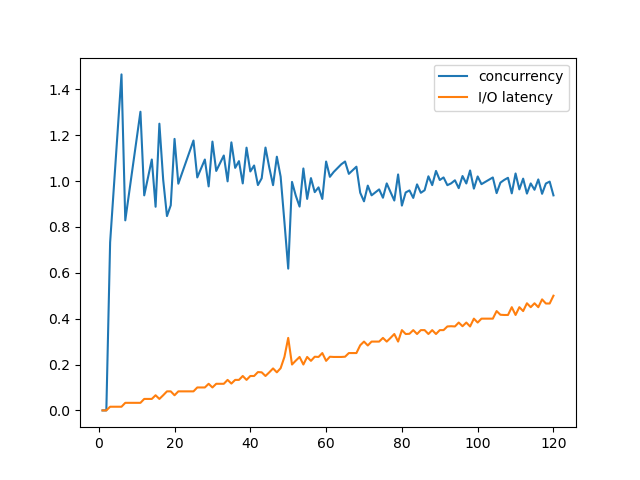
可以发现进程数大约在15时,RAM达到饱和,使得吞吐量趋于稳定
于是,将后续的并发数设置为 15
# 任务二:探究在不同block size条件下,RAM与Disk的性能对比
- 读写函数
void
write_file(int blocksize, bool isrand, char* filepath) {
int fd = open(filepath, O_RDWR | O_CREAT | O_SYNC, 0755);
if (fd == -1) perror("Open");
for (int i = 0;i < MAX_ITER;i++) {
if (write(fd, text, blocksize) != blocksize)
perror("Write");
if (isrand)
lseek(fd, rand() % (MAX_FILESIZE - blocksize), SEEK_SET);
}
lseek(fd, 0, SEEK_SET);
}
void
read_file(int blocksize, bool isrand, char* filepath) {
int fd = open(filepath, O_RDWR | O_CREAT | O_SYNC, 0755);
if (fd == -1) perror("Open");
for (int i = 0;i < MAX_ITER;i++) {
if (read(fd, buff, blocksize) != blocksize)
perror("Read");
if (isrand)
lseek(fd, (MAX_ITER - 1) * (rand() % blocksize), SEEK_SET);
}
lseek(fd, 0, SEEK_SET);
}
时间计算,这里使用
struct timeval来记录时间double calc_time(struct timeval t1, struct timeval t2) { return (double)(t2.tv_sec - t1.tv_sec) * 1000 + (t2.tv_usec - t1.tv_usec) / 1000; }main函数,接受三个参数,argv[1]表示读R或写W,argv[2]表示是RAMR还是DiskD,argv[3]表示是顺序S还是随机Rint main(int argc, char* argv[]) { printf("BlockSize(KB),FileSize(MB),Speed(MB/s)\n"); srand((unsigned)time(NULL)); struct timeval t1, t2; double t; for (int i = 0;i < MAX_BUFFER;i += 16) { strcat(text, "1111111111111111"); } for (int blocksize = 64;blocksize <= 1024 * 32;blocksize = blocksize * 2) { int proc_num = 15; gettimeofday(&t1, NULL); for (int i = 0;i < proc_num;i++) { if (fork() == 0) { if (strcmp(argv[1], "W") == 0) { if (strcmp(argv[2], "R") == 0) { if (strcmp(argv[3], "S") == 0) write_file(blocksize, false, filepathram[i]); else write_file(blocksize, true, filepathram[i]); } else { if (strcmp(argv[3], "S") == 0) write_file(blocksize, false, filepathdisk[i]); else write_file(blocksize, true, filepathdisk[i]); } } else { if (strcmp(argv[3], "R") == 0) { if (strcmp(argv[3], "S") == 0) read_file(blocksize, false, filepathram[i]); else read_file(blocksize, true, filepathram[i]); } else { if (strcmp(argv[3], "S") == 0) read_file(blocksize, false, filepathdisk[i]); else read_file(blocksize, true, filepathdisk[i]); } } exit(0); } } while (wait(NULL) != -1); gettimeofday(&t2, NULL); t = calc_time(t1, t2) / 1000.0; int total_size = blocksize * proc_num * MAX_ITER; printf("%lf,%lf,%lf\n", 1.0 * blocksize / 1024, 1.0 * total_size / 1024 / 1024, 1.0 * total_size / t / 1024 / 1024); // printf("blocksize_KB=%.4fKB,filesize_MB=%.4fMB,speed=%fMB/s\n", // (double)blocksize / 1024.0, // (double)total_size / 1024.0 / 1024.0, // (double)total_size / t / 1024.0 / 1024.0); } return 0; }
完整代码如下
#include<stdio.h>
#include<stdlib.h>
#include<unistd.h>
#include<sys/types.h>
#include<sys/stat.h>
#include<sys/wait.h>
#include<fcntl.h>
#include<time.h>
#include<string.h>
#include <errno.h>
#define MAX_ITER 1000
#define MAX_BUFFER (1024*1024)
#define MAX_FILESIZE (300*1024*1024)
#define MAX_BUFFSIZE (1024*1024*1024)
enum bool{ false, true };
typedef enum bool bool;
const char* filepathram[30] = {
"/root/myram/test1.txt", "/root/myram/test2.txt",
"/root/myram/test3.txt","/root/myram/test4.txt",
"/root/myram/test5.txt","/root/myram/test6.txt",
"/root/myram/test7.txt","/root/myram/test8.txt",
"/root/myram/test9.txt","/root/myram/test10.txt",
"/root/myram/test11.txt", "/root/myram/test12.txt",
"/root/myram/test13.txt","/root/myram/test14.txt",
"/root/myram/test15.txt","/root/myram/test16.txt",
"/root/myram/test17.txt"
};
const char* filepathdisk[30] = {
"/usr/test1.txt", "/usr/test2.txt",
"/usr/test3.txt", "/usr/test4.txt",
"/usr/test5.txt", "/usr/test6.txt",
"/usr/test7.txt", "/usr/test8.txt",
"/usr/test9.txt", "/usr/test10.txt",
"/usr/test11.txt", "/usr/test12.txt",
"/usr/test13.txt", "/usr/test14.txt",
"/usr/test15.txt", "/usr/test16.txt",
"/usr/test17.txt"
};
char text[MAX_BUFFER] = "11111111";
char buff[MAX_BUFFSIZE];
void
write_file(int blocksize, bool isrand, char* filepath) {
int fd = open(filepath, O_RDWR | O_CREAT | O_SYNC, 0755);
if (fd == -1) perror("Open");
for (int i = 0;i < MAX_ITER;i++) {
if (write(fd, text, blocksize) != blocksize)
perror("Write");
if (isrand)
lseek(fd, (MAX_ITER - 1) * (rand() % blocksize), SEEK_SET);
}
lseek(fd, 0, SEEK_SET);
}
void
read_file(int blocksize, bool isrand, char* filepath) {
int fd = open(filepath, O_RDWR | O_CREAT | O_SYNC, 0755);
if (fd == -1) perror("Open");
for (int i = 0;i < MAX_ITER;i++) {
if (read(fd, buff, blocksize) != blocksize)
perror("Read");
if (isrand)
lseek(fd, (MAX_ITER - 1) * (rand() % blocksize), SEEK_SET);
}
lseek(fd, 0, SEEK_SET);
}
double
calc_time(struct timeval t1, struct timeval t2) {
return (double)(t2.tv_sec - t1.tv_sec) * 1000 + (t2.tv_usec - t1.tv_usec) / 1000;
}
int
main(int argc, char* argv[]) {
printf("BlockSize(KB),FileSize(MB),Speed(MB/s)\n");
srand((unsigned)time(NULL));
struct timeval t1, t2;
double t;
for (int i = 0;i < MAX_BUFFER;i += 16) {
strcat(text, "1111111111111111");
}
for (int blocksize = 64;blocksize <= 1024 * 32;blocksize = blocksize * 2) {
int proc_num = 15;
gettimeofday(&t1, NULL);
for (int i = 0;i < proc_num;i++) {
if (fork() == 0) {
if (strcmp(argv[1], "W") == 0) {
if (strcmp(argv[2], "R") == 0) {
if (strcmp(argv[3], "S") == 0)
write_file(blocksize, false, filepathram[i]);
else
write_file(blocksize, true, filepathram[i]);
}
else {
if (strcmp(argv[3], "S") == 0)
write_file(blocksize, false, filepathdisk[i]);
else
write_file(blocksize, true, filepathdisk[i]);
}
}
else {
if (strcmp(argv[3], "R") == 0) {
if (strcmp(argv[3], "S") == 0)
read_file(blocksize, false, filepathram[i]);
else
read_file(blocksize, true, filepathram[i]);
}
else {
if (strcmp(argv[3], "S") == 0)
read_file(blocksize, false, filepathdisk[i]);
else
read_file(blocksize, true, filepathdisk[i]);
}
}
exit(0);
}
}
while (wait(NULL) != -1);
gettimeofday(&t2, NULL);
t = calc_time(t1, t2) / 1000.0;
int total_size = blocksize * proc_num * MAX_ITER;
printf("%lf,%lf,%lf\n", 1.0 * blocksize / 1024,
1.0 * total_size / 1024 / 1024, 1.0 * total_size / t / 1024 / 1024);
// printf("blocksize_KB=%.4fKB,filesize_MB=%.4fMB,speed=%fMB/s\n",
// (double)blocksize / 1024.0,
// (double)total_size / 1024.0 / 1024.0,
// (double)total_size / t / 1024.0 / 1024.0);
}
return 0;
}
编写脚本 run.sh 如下
clang mission2.c -o mission2
./mission2 W R S > RamSeqWrite.csv
echo RamSeqWrite Completed
./mission2 R R S > RamSeqRead.csv
echo RamSeqRead Completed
rm myram/*.txt
./mission2 W D S > DiskSeqWrite.csv
echo DiskSeqWrite Completed
./mission2 R D S > DiskSeqRead.csv
echo DiskSeqRead Completed
rm /usr/*.txt
./mission2 W R R > RamRdWrite.csv
echo RamRdWrite Completed
./mission2 R R R > RamRdRead.csv
echo RamRdRead Completed
rm myram/*.txt
./mission2 W D R > DiskRdWrite.csv
echo DiskRdWrite Completed
./mission2 R D R > DiskRdRead.txt
echo DiskRdRead Completed
rm /usr/*.txt
在 MINIX 环境下 chmod u+x run.sh 与 ./run.sh 即可运行。
将输出文件导入到 excel 后作图:
也可以用 python 作图
import numpy as np
import pandas as pd
import matplotlib.pyplot as plt
filepath = [
"DataSet/RamSeqWrite.csv", "DataSet/RamSeqRead.csv",
"DataSet/RamRdWrite.csv", "DataSet/RamRdRead.csv",
"DataSet/DiskSeqWrite.csv", "DataSet/DiskSeqRead.csv",
"DataSet/DiskRdWrite.csv", "DataSet/DiskRdRead.csv",
]
check = [(0, 4), (1, 5), (2, 6), (3, 7)]
title = ['Seq Write', 'Seq Read', 'Random Write', 'Random Read']
for i in range(len(check)):
df1 = pd.read_csv(filepath[check[i][0]])
df2 = pd.read_csv(filepath[check[i][1]])
x = df1['BlockSize(KB)'].to_numpy()
y1 = df1['Speed(MB/s)'].to_numpy()
y2 = df2['Speed(MB/s)'].to_numpy()
plt.plot(x, y1, label='Ram')
plt.plot(x, y2, label='Disk')
plt.xlabel('BlockSize(KB)')
plt.ylabel('Speed(MB/s)')
plt.title(title[i])
plt.legend()
plt.show()
作图如下:
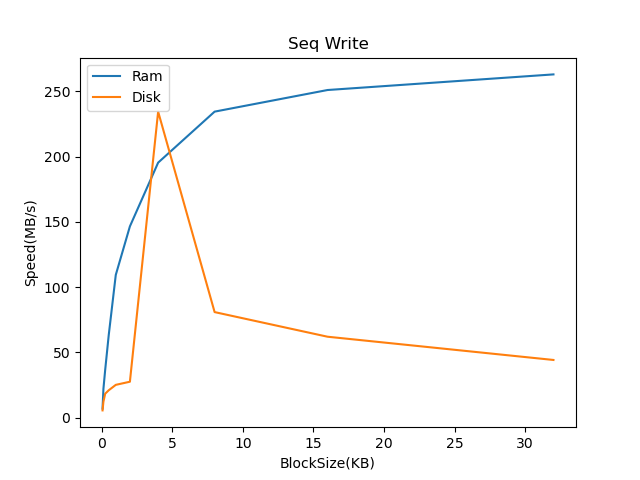
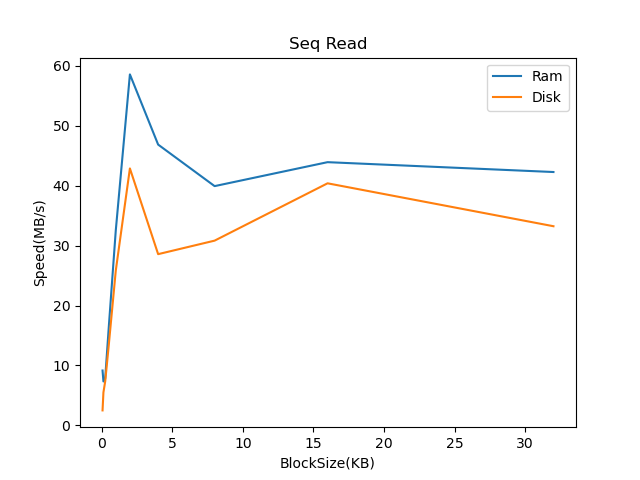
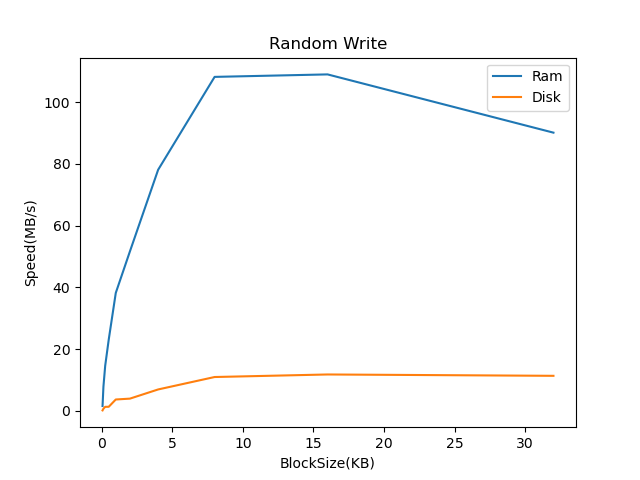
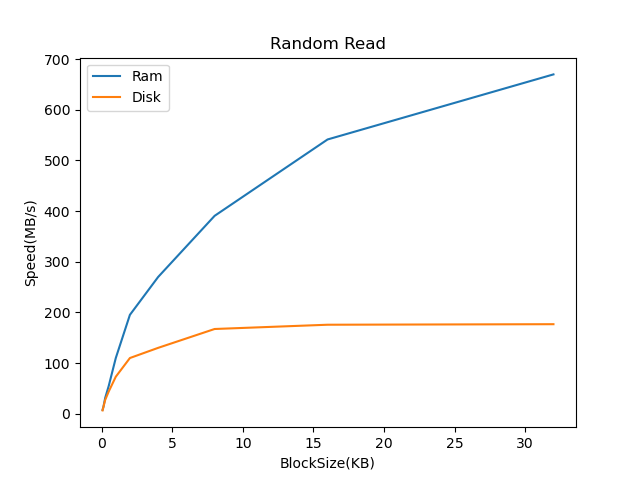
# 总结
微内核真麻烦😐
设计是好设计,好就好在_______________________________
